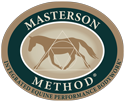How Often Can I do this Work?
Every horse is different. Different horses have different histories and different things going on, and different nervous systems. A draft horse has a different nervous system than say, a thoroughbred. And with this method you’re working with the horse’s nervous system. His nervous system is releasing the tension.
In general, if something you do while working on a horse gets a huge release and makes a big change in the horse’s behavior during the session, then the horse is going to need more time before the next session.
I would say as a rule, if you were to do these light techniques every day for an hour, it’s going to be too much for your horse. If you do this every other day and don’t do too long of a session, then that might be fine for your horse, or if you do just a little bit every day, then it might be ok.
But don’t be too concerned that you’re doing too much if you’re paying attention to what the horse is telling. The horse will tell you, ultimately, if you’re doing too much.
How long should a session be?
You have to remember that you’re working with the horse’s nervous system. Too much work can cause the horse’s nervous system to get overloaded.
The signs that this is happening are;
- the horse will get antsy to the point where he’ll all of a sudden not let you touch him, or
- he’ll just shut down and stop giving you responses.
You could get a huge release within 15 minutes, or you could go an hour, and gradually get the horse to completely zone out. Or as I said above, he could tell you in no uncertain terms to stop.
Some other things
The lighter you go, the deeper the tension that the horse releases. You can use pressure to massage the fibers in the muscles of the lower back for example and get those muscles to relax and release tension. That works to relieve tension in that muscle.
But if you search lightly for a response in the muscles of the lower back with no pressure, and keep the horse’s attention (stay) on the response long enough, then the horse’s nervous system will start to release deeper tension associated with that response. When the horse’s nervous system relaxes, it releases deeper postural and core muscle tension that the horse has been using to compensate for pain and tension in the lower back.












